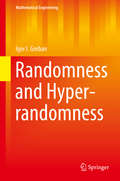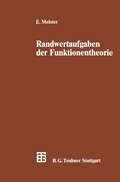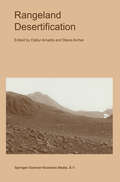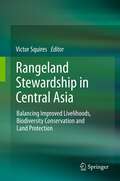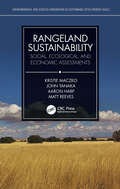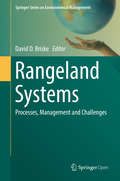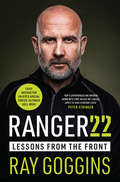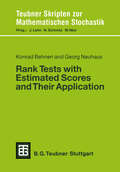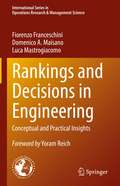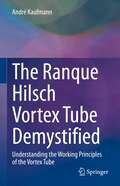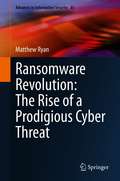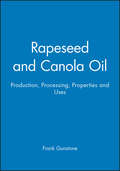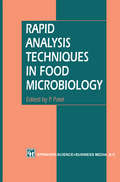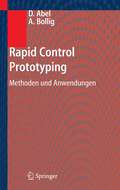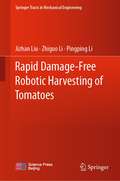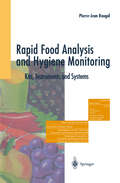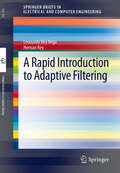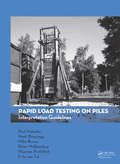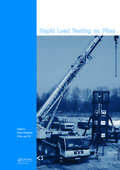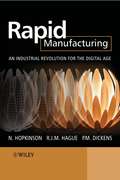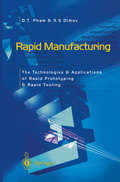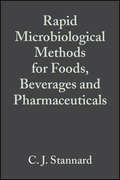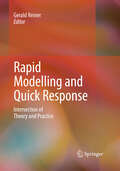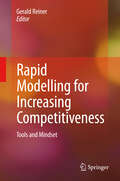- Table View
- List View
Randomness and Hyper-randomness (Mathematical Engineering)
by Igor I. GorbanThe monograph compares two approaches that describe the statistical stability phenomenon – one proposed by the probability theory that ignores violations of statistical stability and another proposed by the theory of hyper-random phenomena that takes these violations into account. There are five parts. The first describes the phenomenon of statistical stability. The second outlines the mathematical foundations of probability theory. The third develops methods for detecting violations of statistical stability and presents the results of experimental research on actual processes of different physical nature that demonstrate the violations of statistical stability over broad observation intervals. The fourth part outlines the mathematical foundations of the theory of hyper-random phenomena. The fifth part discusses the problem of how to provide an adequate description of the world.The monograph should be interest to a wide readership: from university students on a first course majoring in physics, engineering, and mathematics to engineers, post-graduate students, and scientists carrying out research on the statistical laws of natural physical phenomena, developing and using statistical methods for high-precision measurement, prediction, and signal processing over broad observation intervals.To read the book, it is sufficient to be familiar with a standard first university course on mathematics.
Randwertaufgaben der Funktionentheorie: Mit Anwendungen auf singuläre Integralgleichungen und Schwingungsprobleme der mathematischen Physik (Leitfäden der angewandten Mathematik und Mechanik)
by Erhard MeisterRangeland Desertification (Advances in Vegetation Science #19)
by Olafur ArnaldsDesertification has occurred worldwide. The biophysical and socio-economic complexity of this phenomenon has challenged our ability to categorize, inventory, monitor and repair the condition of degraded lands. One of the most important distinctions to be made in relation to land degradation is between cultivated land used for annual crop production and `rangelands'. Grazing by free-roaming livestock is the traditional primary use of the world's rangelands. However, there is growing recognition of the importance of these vast acreages for wildlife habitat, hydrology and ground water recharge, recreation and aesthetics. This text focuses on the desertification of rangelands and explores processes, problems and solutions. Chapters in the first section evaluate interactions between `natural' and human-induced disturbance regimes, thresholds, and non-linear change with respect to vegetation, hydrology, nutrients and erosion. Chapters in the second section examine socio-economic constraints and approaches for preventing and reversing degradation. The book provides a contemporary, process-oriented perspective on rangeland degradation of value to students, policy-makers and professionals alike.
Rangeland Stewardship in Central Asia: Balancing Improved Livelihoods, Biodiversity Conservation and Land Protection
by Victor SquiresThis volume of 18 chapters is the work of more than 30 authors, many of whom are natives of the Central Asian region or are researchers who have dedicated a large part of their working lives to studying the development dynamics in this vast and fascinating region. The work focuses on the 20 years since the collapse of the Soviet Union in 1990. But it also traces the attitudes of land users to the land dating from before the late 19th century, when Russian conquest and colonization occurred, and through the upheavals caused by Soviet-style collectivization and sedentarization. The book is rich with new data presented in 68 easy to understand charts/graphs (many in color) and 50 Tables. Information was generated for this book by experts working in-country. It presents for the first time in English a digest of plethora of previously inaccessible Russian reports and scientific literature that will be invaluable for development agencies, including UN, World Bank, Asian Development Bank, Islamic Bank as well as to students of this vast and fascinating region who seek up to date and authoritive information.
Rangeland Sustainability: Social, Ecological, and Economic Assessments (Environmental and Societal Dimensions of Sustainable Development Goals)
by Kristie Maczko Aaron Harp John Tanaka Matt ReevesThis book provides an integrated description of the indicators of rangeland sustainability that capture ecological, economic, and social dimensions. It takes a fresh look at the information available on current and emerging issues across rangelands, and presents collaborative research for future progress. Authors offer a framework for evaluating rangeland sustainability, the best available data to use, as well as an interactive tool for use at a variety of geographical scales. Readers with limited knowledge of rangelands, as well as professional rangeland ecologists and land managers, will gain an understanding of the best tools available today to assess sustainability across rangeland ecosystems in the U.S.
Rangeland Sustainability: Social, Ecological, and Economic Assessments (Environmental and Societal Dimensions of Sustainable Development Goals)
by Kristie Maczko Aaron Harp John Tanaka Matt ReevesThis book provides an integrated description of the indicators of rangeland sustainability that capture ecological, economic, and social dimensions. It takes a fresh look at the information available on current and emerging issues across rangelands, and presents collaborative research for future progress. Authors offer a framework for evaluating rangeland sustainability, the best available data to use, as well as an interactive tool for use at a variety of geographical scales. Readers with limited knowledge of rangelands, as well as professional rangeland ecologists and land managers, will gain an understanding of the best tools available today to assess sustainability across rangeland ecosystems in the U.S.
Rangeland Systems: Processes, Management and Challenges (Springer Series on Environmental Management)
by David D. BriskeThis book is open access under a CC BY-NC 2.5 license.This book provides an unprecedented synthesis of the current status of scientific and management knowledge regarding global rangelands and the major challenges that confront them. It has been organized around three major themes. The first summarizes the conceptual advances that have occurred in the rangeland profession. The second addresses the implications of these conceptual advances to management and policy. The third assesses several major challenges confronting global rangelands in the 21st century. This book will compliment applied range management textbooks by describing the conceptual foundation on which the rangeland profession is based. It has been written to be accessible to a broad audience, including ecosystem managers, educators, students and policy makers. The content is founded on the collective experience, knowledge and commitment of 80 authors who have worked in rangelands throughout the world. Their collective contributions indicate that a more comprehensive framework is necessary to address the complex challenges confronting global rangelands. Rangelands represent adaptive social-ecological systems, in which societal values, organizations and capacities are of equal importance to, and interact with, those of ecological processes. A more comprehensive framework for rangeland systems may enable management agencies, and educational, research and policy making organizations to more effectively assess complex problems and develop appropriate solutions.
Ranger 22: Lessons From The Front
by Ray Goggins‘The path I have travelled, the things I have done and the people I have met in crisis situations have given me a window into those qualities that make us perform. My military training created a mindset, an outlook and skills that can be channelled into any situation.’From the hills of south Lebanon to the monsoon jungles of Southern Asia, Ray Goggins has operated in a life-and-death world. In the suffocating humidity of Liberia, the mountains of Afghanistan and the snow-covered Balkans, Ray has seen the best and worst qualities in himself and others. From conflict zones to terrorist attacks and hostage rescues, Ray has learned the greatest life lessons: how to control fear, how to react calmly and positively and how to create a strong baseline from which to take action.In this remarkable book he takes us on an exhilarating journey through his incredible career and draws on the valuable lessons to help all of us deal better with life, whatever the situation.
Rank Tests with Estimated Scores and Their Application (Teubner Skripten zur Mathematischen Stochastik)
by Georg NeuhausRankings and Decisions in Engineering: Conceptual and Practical Insights (International Series in Operations Research & Management Science #319)
by Fiorenzo Franceschini Luca Mastrogiacomo Domenico A. MaisanoThis book focuses on decision-making problems in engineering. It investigates the ranking aggregation problem and the related features, such as input/output data, simplification hypotheses, importance hierarchy of experts. In addition to a well-structured overview of several interesting, consolidated methodological approaches, it presents innovative approaches that can also be applied profitably in other fields. The fascinating selection of topics included is based on research that has been developed in the past twenty years. The descriptions are supported by figures, tables, flowcharts, diagrams, examples and practical case studies. The book is an ideal resource for engineering academics, practitioners, technicians and students, who do not necessarily have an in-depth knowledge of decision-making. It is also a thought-provoking read for engineers and academics looking for innovative ways to improve engineering processes in a variety of fields, such as conceptual design, quality improvement, reliability engineering. “Today, rankings are exercised in all spheres of life, products are ranked on Amazon and similar platforms; services such as restaurants and hotels on platforms such as TripAdvisor; and other services such as lectures or even medical treatment on different specialized platforms. We often make our daily decisions based on these rankings. The quality of our decisions depends on our ability to select appropriate methods to fit the context and needs. We need to be familiar with the theory and practice of these methods to make them useful. To this purpose, this book is an important addition to the bookshelves of academics and professionals, not only from engineering. The connection between theory and practice is weaved throughout the book, making it useful for practitioners also.” Prof. Yoram Reich, Full Professor and Head of Systems Engineering research Initiative at Tel Aviv University (Israel), Editor-in-Chief of “Research in Engineering Design”
The Ranque Hilsch Vortex Tube Demystified: Understanding the Working Principles of the Vortex Tube
by André KaufmannThe book describes the thermodynamics, fluid dynamics, and working principle of the Ranque Hilsch Vortex Tube. Although vortex tubes have been around for a long time, different explications of their fundamental physics and operation can be found in literature and on the internet. This volume investigates the working principle based on thermodynamics and fluid dynamics. It provides full explication of these parameters in one single work along with results of new investigations not published elsewhere. In addition, the book features a wealth of illustrations on various aspects of the vortex tube that make it easy to read and understand.
Ransomware Revolution: The Rise of a Prodigious Cyber Threat (Advances in Information Security #85)
by Matthew RyanThis book explores the genesis of ransomware and how the parallel emergence of encryption technologies has elevated ransomware to become the most prodigious cyber threat that enterprises are confronting. It also investigates the driving forces behind what has been dubbed the ‘ransomware revolution’ after a series of major attacks beginning in 2013, and how the advent of cryptocurrencies provided the catalyst for the development and increased profitability of ransomware, sparking a phenomenal rise in the number and complexity of ransomware attacks. This book analyzes why the speed of technology adoption has been a fundamental factor in the continued success of financially motivated cybercrime, and how the ease of public access to advanced encryption techniques has allowed malicious actors to continue to operate with increased anonymity across the internet. This anonymity has enabled increased collaboration between attackers, which has aided the development of new ransomware attacks, and led to an increasing level of technical complexity in ransomware attacks. This book highlights that the continuous expansion and early adoption of emerging technologies may be beyond the capacity of conventional risk managers and risk management frameworks.Researchers and advanced level students studying or working in computer science, business or criminology will find this book useful as a reference or secondary text. Professionals working in cybersecurity, cryptography, information technology, financial crime (and other related topics) will also welcome this book as a reference.
Rapeseed and Canola Oil: Production, Processing, Properties and Uses
by Frank GunstoneRapeseed is now the second largest oilseed crop after soybean, and the third largest vegetable oil after soybean oil and palm oil, and it is therefore an important contributor to the annual supply of vegetable oils required to meet an increasing demand. This volume provides comprehensive coverage of rapeseed oil and its close relative, canola oil, from production (agronomic) aspects, through extraction to refining and processing. Chemical composition, physico-chemical properties, food and non-food uses are considered in detail, and a chapter is included on future prospects, including oils available by means of genetic manipulation. This is a book for oils and fats chemists and technologists in the food and oleochemical industries, chemical engineers in the processing industry, nutritionists and seed technologists.
Rapid Analysis Techniques in Food Microbiology
by P. D. PatelThe food industry, with its diverse range of products (e.g. short shelf-life foods, modified atmosphere packaged products and minimally processed products) is governed by strict food legislation, and microbiological safety has become a key issue. Legally required to demonstrate 'due diligence', food manufacturers are demanding analytical techniques that are simple to use, cost effective, robust, reliable and can provide results in 'real time'. The majority of current microbiological techniques (classical or rapid), particularly for the analysis of foodborne pathogens, give results that are only of retrospective value and do not allow proactive or reactive measures to be imple mented during modem food production. Rapid methods for microbial analysis need to be considered in the context of modem Quality Assurance (QA) systems. This book addresses microbiologists, biochemists and immunologists in the food industry, the public health sector, academic and research institutes, and manufacturers of kits and instruments. This volume is an up-to-date account of recent developments in rapid food microbiological analysis, current approaches and problems, rapid methods in relation to QA systems, and future perspectives in an intensely active field. P.D.P. Contributors Public Health Laboratory, Royal Preston Hospital, PO Box F.J. Bolton 202, Sharoe Green Lane North, Preston PR2 4HG, UK. D. M. Gibson Ministry of Agriculture, Fisheries and Food, Torry Research Station, 135 Abbey Road, Aberdeen AB9 8DG, Scotland. P.A. Hall Microbiology and Food Safety, Kraft General Foods, 801 Waukegan Road, Glenview, Illinois 60025, USA.
Rapid Control Prototyping: Methoden und Anwendungen
by Dirk Abel Alexander BolligDas Buch zeigt neue Methodiken, Anforderungen und Möglichkeiten, die sich aufgrund rechnergestützter Entwurfsprozesse für die Regelungs-, Steuerungs- und Automatisierungstechnik ergeben. Die Autoren behandeln die Theorie zum Regelungs- und Steuerungsentwurf in Grundzügen und beleuchten die Simulation dynamischer Systeme. Das Buch enthält zahlreiche durchgerechnete Beispiele mit Lösungen.
Rapid Damage-Free Robotic Harvesting of Tomatoes (Springer Tracts in Mechanical Engineering)
by Jizhan Liu Zhiguo Li Pingping LiThis book shares the latest findings on this topic, systematically introduces readers to advances made in robotic harvesting around the globe, and explores the relations between the development of robotic harvesting and the respective social/economic conditions and agricultural business patterns in various countries/regions. Due to the unstructured setting it is used in, and to the significant differences between individual fruit and vegetable targets, robotic harvesting is currently considered to be one of the most challenging robotics technologies. Accordingly, research into this area involves the integration of various aspects, including biomechanics, optimization design, advanced perception and intelligent control. In addition to rapid and damage-free robotic harvesting, which reflects the multidisciplinary nature of the topic, further aspects addressed include gripping collisions with viscoelastic objects, using lasers to cut plant material, plant-fruit response to vacuum sucking and pulling, and performance probability distribution. Highlighting outstanding innovations and reflecting the latest advances in intelligent agricultural equipment in China, the book offers a unique and valuable resource.
Rapid Food Analysis and Hygiene Monitoring: Kits, Instruments and Systems
by Pierre-Jean RaugelPROF. DR. ELKE ANKlAM Food control is essential for consumer protection. Due to the fact that agricul ture and food technology have increased rapidly in the past the analytical prob lems concerning food have become more complex. The consumer expects com petitively priced food of consistently high quality. The main consumer concerns are food safety and food quality including authenticity proof. Many national or international official, validated, reference or routine methods are existing. Food be performed rapidly especially in the fields of microbiological control has to contamination and customs control. This handbook describes many kits, instruments and systems used for quality control of food. The tools listed are not only restricted to validated analytical methods but are also foreseen for routine and screening methods. In addition, an address list of manufacturers, distributors and sales agencies is given to gether with a list and information concerning selected expert laboratories. In this edition, emphasis is put on validation procedures of three organizations (AOAC, AFNOR and Microval). The purpose of this book is to facilitate the purchase and use of kits needed for food analysis and is therefore an important help for food analysts.
A Rapid Introduction to Adaptive Filtering (SpringerBriefs in Electrical and Computer Engineering)
by Leonardo Rey Vega Hernan ReyIn this book, the authors provide insights into the basics of adaptive filtering, which are particularly useful for students taking their first steps into this field. They start by studying the problem of minimum mean-square-error filtering, i.e., Wiener filtering. Then, they analyze iterative methods for solving the optimization problem, e.g., the Method of Steepest Descent. By proposing stochastic approximations, several basic adaptive algorithms are derived, including Least Mean Squares (LMS), Normalized Least Mean Squares (NLMS) and Sign-error algorithms. The authors provide a general framework to study the stability and steady-state performance of these algorithms. The affine Projection Algorithm (APA) which provides faster convergence at the expense of computational complexity (although fast implementations can be used) is also presented. In addition, the Least Squares (LS) method and its recursive version (RLS), including fast implementations are discussed. The book closes with the discussion of several topics of interest in the adaptive filtering field.
Rapid Load Testing on Piles: Interpretation Guidelines
by Paul Holscher Henk Brassinga Michael Brown Peter Middendorp Maarten Profittlich Frits A. van TolA Rapid Load Test (RLT), developed to determine the initial stiffness and bearing capacity, is an economical and practical alternative to a Static Load Test (SLT). The broad application of RLT, however, was hampered by uncertainty about the interpretation of the test results. This book offers clear guidance on the available analysis techniques and
Rapid Load Testing on Piles
by Paul Holscher Frits A. Van TolTo obtain data about the stiffness and bearing capacity of a foundation pile, the Rapid Load Test could be an effective and economic alternative for a static load test. In order to judge this, the influence of rate effects in clay and pore water pressures in sand should first be understood. This book presents the latest developments in the research
Rapid Manufacturing: An Industrial Revolution for the Digital Age
by Neil Hopkinson Richard Hague Philip DickensRapid Manufacturing is a new area of manufacturing developed from a family of technologies known as Rapid Prototyping. These processes have already had the effect of both improving products and reducing their development time; this in turn resulted in the development of the technology of Rapid Tooling, which implemented Rapid Prototyping techniques to improve its own processes. Rapid Manufacturing has developed as the next stage, in which the need for tooling is eliminated. It has been shown that it is economically feasible to use existing commercial Rapid Prototyping systems to manufacture series parts in quantities of up to 20,000 and customised parts in quantities of hundreds of thousands. This form of manufacturing can be incredibly cost-effective and the process is far more flexible than conventional manufacturing. Rapid Manufacturing: An Industrial Revolution for the Digital Age addresses the academic fundamentals of Rapid Manufacturing as well as focussing on case studies and applications across a wide range of industry sectors. As a technology that allows manufacturers to create products without tools, it enables previously impossible geometries to be made. This book is abundant with images depicting the fantastic array of products that are now being commercially manufactured using these technologies. Includes contributions from leading researchers working at the forefront of industry. Features detailed illustrations throughout. Rapid Manufacturing: An Industrial Revolution for the Digital Age is a groundbreaking text that provides excellent coverage of this fast emerging industry. It will interest manufacturing industry practitioners in research and development, product design and materials science, as well as having a theoretical appeal to researchers and post-graduate students in manufacturing engineering, product design, CAD/CAM and CIFM.
Rapid Manufacturing: The Technologies and Applications of Rapid Prototyping and Rapid Tooling
by Duc Pham S.S. DimovRapid prototyping is an exciting new technology used to create physical models and functional prototypes directly from CAD models. Rapid tooling concerns the production of tooling using parts manufactured by rapid prototyping. The book describes the characteristics and capabilities of the main known rapid prototyping processes. It covers in detail various commercially available processes such as: Stereolithography (SLA), Selective Laser Sintering (SLS), and others. The text places a strong emphasis on practical applications and contains an abundance of photographs and diagrams to illustrate clearly the principles of the machines and processes involved.
Rapid Microbiological Methods for Foods, Beverages and Pharmaceuticals (Society for Applied Bacteriology)
by C. J. Stannard S. B. Petitt F. A. SkinnerThis book considers the rapid microbiological techniques that are now increasingly used in industry as alternatives to more conventional methods. Although many of the pioneering studies in this field have taken place in clinical laboratories, the materials listed and organisms sought for foods, beverages and pharmaceuticals are much more varied. In this volume, leading experts from research and industry review the wide variety of approaches that are needed in an industrial setting. The methods described include electrometric techniques, ATP assay, and immunological methods for a wide range of organisms from salmonellas to viruses, each chapter drawing on the authors direct experience in industry to give a highly practical guide. The book should prove invaluable to those in the food, beverage and pharmaceutical industries, or in research and training, who require an up-to-date survey of the use of rapid microbiological methods.
Rapid Modelling and Quick Response: Intersection of Theory and Practice
by Gerald ReinerRapid Modelling and Quick Response presents new research developments in the fields of rapid modelling and quick response linked with performance improvements (based on lead time reduction, etc., as well as financial performance measures). The papers and teaching cases in this book were presented at the second Rapid Modelling Conference: "Quick Response – Intersection of Theory and Practice". The main focus of this collection is the transfer of knowledge from theory to practice, providing the theoretical foundations for successful performance improvement. This conference volume challenges the traditional notions of rapid modelling, and offers valuable contributions to the scientific communities of operations management, production management, supply chain management, industrial engineering and operations research. Rapid Modelling and Quick Response will give the interested reader (researcher, as well as practitioner) a good overview of new developments in this field.
Rapid Modelling for Increasing Competitiveness: Tools and Mindset
by Gerald ReinerA Perspective on Two Decades of Rapid Modeling It is an honor for me to be asked to write a foreword to the Proceedings of the 1st Rapid Modeling Conference. In 1987, when I coined the term “Rapid Modeling” to denote queuing modeling of manufacturing systems, I never imagined that two decades later there would be an international conference devoted to this topic! I am delighted to see that there will be around 40 presentations at the conference by leading researchers from aroundthe world, and about half of these presentationsare represented by written papers published in this book. I congratulate the conference organizers and program committee on the success of their efforts to hold the ?rst ever conference on Rapid Modeling. Attendees at this conferencemight?nd it interesting to learn about the history of the term Rapid Modeling in the context it is used here. During the fall of 1986 I was invited to a meeting at the Headquarters of the Society of Manufacturing Engineers (SME) in Dearborn, Michigan. By that time I had successfully demonstrated s- eral industry applications of queuing network models at leading manufacturers in the USA. Although in principle the use of queuing networks to model manufact- ing systems was well known in the OR/MS community and many papers had been published,the actual use of suchmodelsby manufacturingprofessionalswas almost nonexistent.
